As 2017 came to a close, Gartner released its annual top technology trends at the Gartner Symposium/ITxpo 2017 in Orlando, FL at the beginning of October 2017. David Cearley, VP and Gartner Fellow presented this year’s categorized list.
During his presentation, Cearley discussed the attention and increasing amount of intelligence services, how digital information is growing necessary to unite the world, and the requirement for a mesh – a secure set of connections amongst technology, services, and data. He referred to this as the “Intelligent Digital Mesh.”
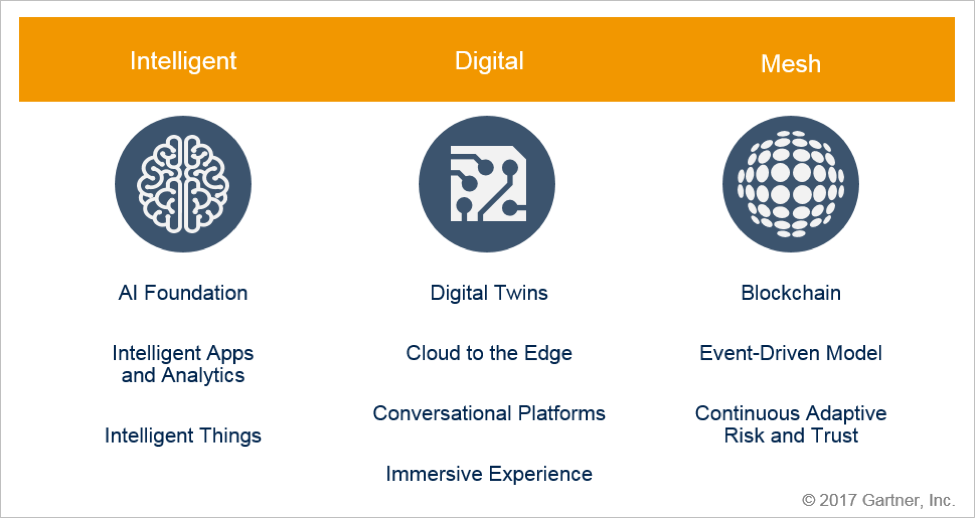
See Gartner’s top 10 strategic technology trends below:
AI foundation: Interest in AI is rising, as shown by an increase of more than 500% in the number of inquiry calls from Gartner clients about topics related to AI in the past year. Creating systems that learn, adapt, and potentially act autonomously will be a major battleground for technology vendors through at least 2020. “AI techniques are evolving rapidly and organizations will need to invest significantly in skills, processes and tools to successfully exploit these techniques and build AI-enhanced systems,” said Cearley. “Investment areas can include data preparation, integration, algorithm and training methodology selection, and model creation. Multiple constituencies including data scientists, developers and business process owners will need to work together.”
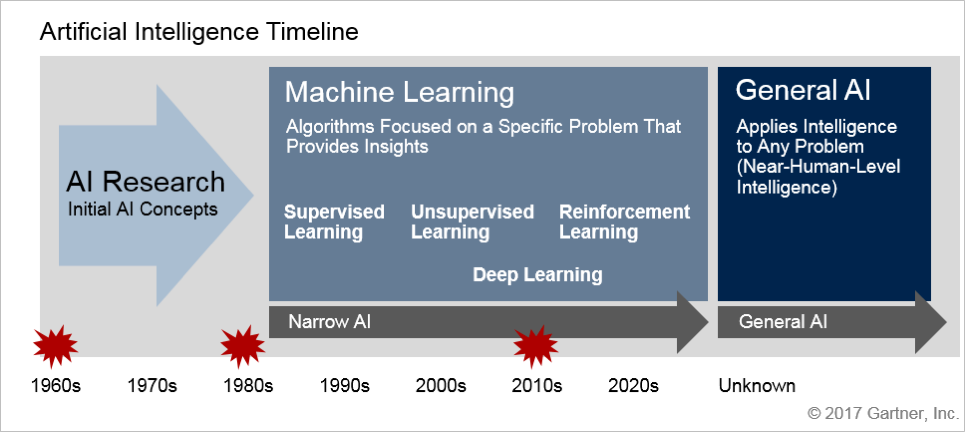
We are starting to see more and more products with enhanced AI capabilities enter the market with stiff competition amongst several well-known technology companies. I am specifically referring to the on-going battle between Amazon Alexa, Google Home, and now Apple HomePod. These three devices have such vast capabilities that will only continue to evolve as we refine and shape what our needs are from an AI perspective.
Intelligent apps and analytics: Organizations are applying AI techniques to create new application categories, such as virtual customer assistants. Intelligent apps have the potential to transform the landscape of work and the structure of the workplace. Cearley talked about augmented data discovery and analysis to auto-generate models and make this data available for “citizen data scientists.” Over the next few years, Cearley said he expects 90 percent of the business intelligence tools to add natural language processing.
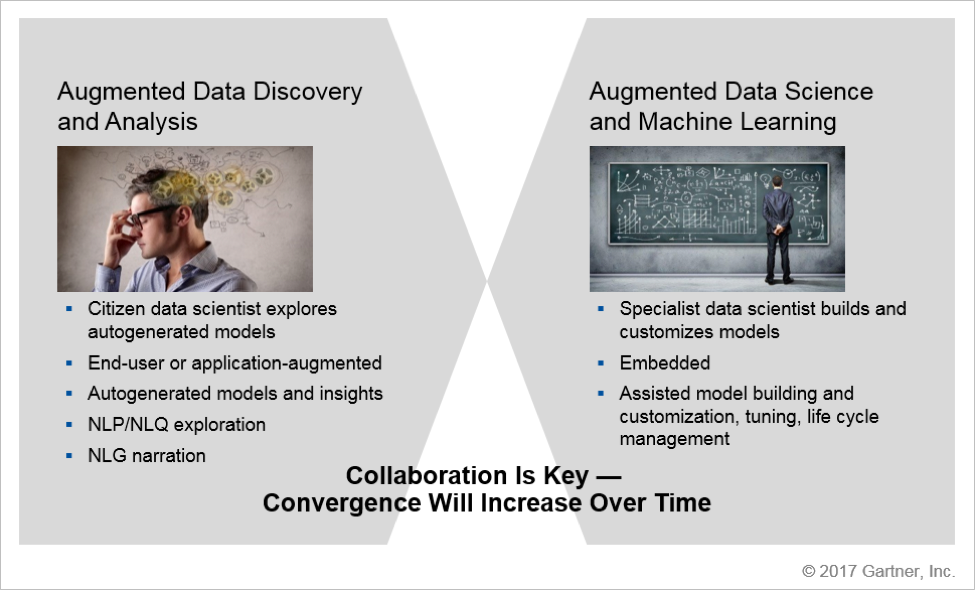
I am part of the generation that would rather solve problems with a particular vendor as long as I don’t have to get on the phone and go through an automated decision tree. It is great to be able to achieve what I need to through some kind of intelligent virtual assistant. Where I have experienced this recently is in the logistics industry where I may have something being delivered and I need to reschedule the date and time.
Intelligent things: These are physical things that go beyond the execution of rigid programming models and exploit AI to deliver sophisticated behaviors that interact more naturally with their surroundings and with people. Such solutions include autonomous vehicles, robots, and drones, as well as the extension of existing Internet of Things solutions. Cearley expects that in the near future these will work mainly in controlled settings, before graduating to general environments (such as unrestricted driving). He talked about multiple drones and other things working together to create “swarm intelligence.” An example of this is Intel’s use of a drone swarm for the U.S. Super Bowl halftime show in 2017.
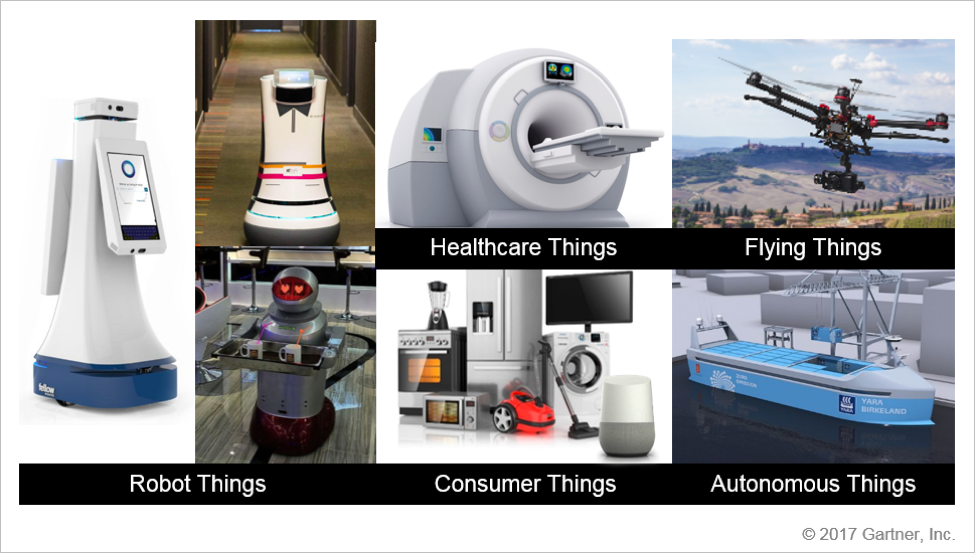
Drones have been a fascination of mine as I have my very own DJI Phantom 4 Pro and am pursuing my Part 107 commercial UAV license. DJI is the leader in consumer drones and with the launch of their drone, Tello, they created an affordable market for all types of people to not only afford an entry level drone but also an open SDK to learn how to write code to operate the drone. Intel has really paved the way in showing the world the advancements in automated drone operation, especially during the opening ceremony of the Olympics in Pyeongchang this year. They set a record with 1,218 drones joined in a mechanical murmuration. If you haven’t seen it, I encourage you to take a look here.
Digital twin: A digital twin is a digital representation of real-world entities or systems. “Over time, digital representations of virtually every aspect of our world will be connected dynamically with their real-world counterpart and with one another and infused with AI-based capabilities to enable advanced simulation, operation and analysis,” said Cearley. “City planners, digital marketers, health care professionals and industrial planners will all benefit from this long-term shift to the integrated digital twin world.” His examples included GE monitoring aircraft engines, with some airlines reporting reducing downtime by 30 to 50 percent. He also talked about digital twins in use for optimization on a wind farm, where they are used to ascertain how to best adjust blade orientation.
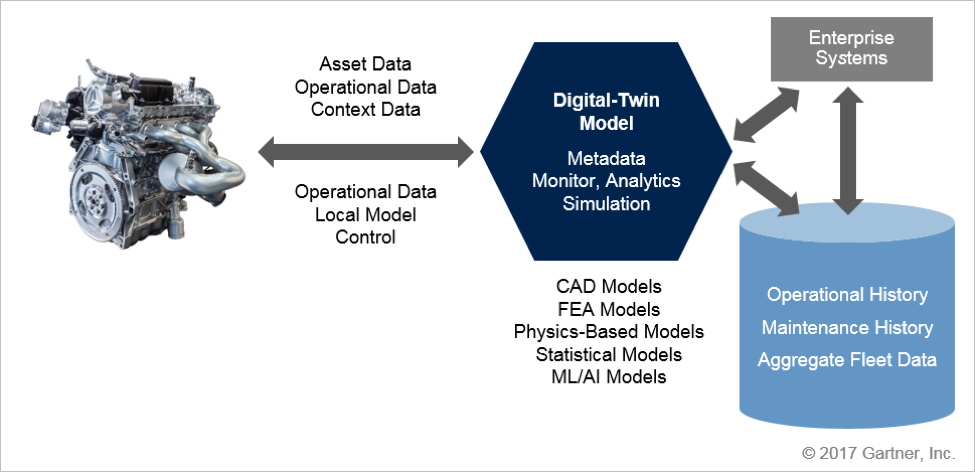
Some great examples we are starting to see out there are in the healthcare industry – a surgeon leverages a digital visualization of an organ before operating on it. Or, in NASCAR, a driver’s team will visualize a race car’s engine, so they can identify any required maintenance, such as a given component that is close to burning out.
Cloud to the edge: Edge computing defines a computing topology in which data processing, content gathering, and distribution are placed closer to the sources and syncs of this information. “When used as complementary concepts, cloud can be the style of computing used to create a service-oriented model and a centralized control and coordination structure with edge being used as a delivery style allowing for disconnected or distributed process execution of aspects of the cloud service,” said Cearley. This is the concept that some devices, such as PCs or mobile devices, run on the edge, while other things are centralized, such as in the cloud. This swings back and forth, and Cearley said that “everything old is new again.” One trend here is using the cloud as a point of coordination or control for the edge, with examples such as Office 365, which is managed in the cloud but has the traditional desktop Office software on the edge.

Conversational platforms: Chatbots are altering how people interact with the evolving digital world. This will be in the form of inquiry and command experiences where a person will ask a question and the platform is able to reply. Rather than having to learn how the computer communicates (aka learn the interface), conversational platforms enable the user to convey their intent using natural language. Over the next few years, conversational interfaces based on natural-language interfaces will become the main design goal for user interaction. Gartner predicts that, by 2019, 20% of users’ interactions with smartphones will be through VPAs. The important thing here is, “flipping the paradigm,” so that instead of people adjusting to technology, the technology will adjust to people, Cearley said.

This is becoming more and more common with companies leveraging chatbot services. The one I have had exposure to the most is Domino’s while ordering a pizza. They allow customers access to their full menu to order pizza while leveraging Facebook Messenger, or you can even just send them a pizza emoji via text message.
Immersive experience: Experiences such as virtual, augmented, and mixed reality will also change how people interact and perceive the world. Businesses can use an immersive experience to create real-life situations and apply them to design, training, and visualization processes. Gartner expects that by 2020, the market for head-mounted virtual and augmented reality devices will exceed 35 million devices and generate $75 billion in revenue. Cearley pushed the concept of “mixed reality” with lots of sensors, and gave examples featuring companies such as Sotheby’s, Idea, and the Void. From now until 2022, he suggested enterprises look more at specific solutions and said that more comprehensive platforms should emerge after that.
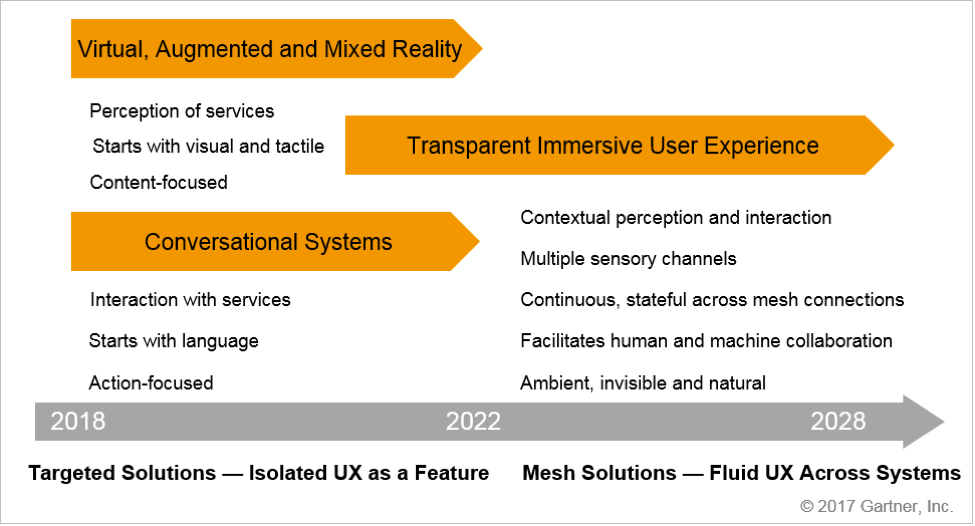
It seems that this year’s CES 2018 had a lot to offer around the ability to create an immersive experience, and now that consumers have everyday devices that can interact with this kind of technology it becomes more of a norm. I have two 360-degree cameras and I have been learning how to create an immersive experience to prepare for a trip to Europe this summer.
Blockchain: This is evolving from a digital currency infrastructure into a platform for digital transformation being used in a number of different apps, such as government, healthcare, manufacturing, media distribution, identity verification, title registry, and supply chain. Cearley focused on blockchain as a shared and distributed mesh, which is independent of an individual application but has so far been used mainly in financial services and government. He said about 40 percent of the total value of blockchain will come from supply chain management. By 2022, Gartner predicts that 30 percent of higher education institutions will be using blockchain for educational credentials. However, he acknowledged that there are barriers to the broader use of blockchain, such as immature technologies and concepts, uncertain and unverified in vital at-scale business operations.
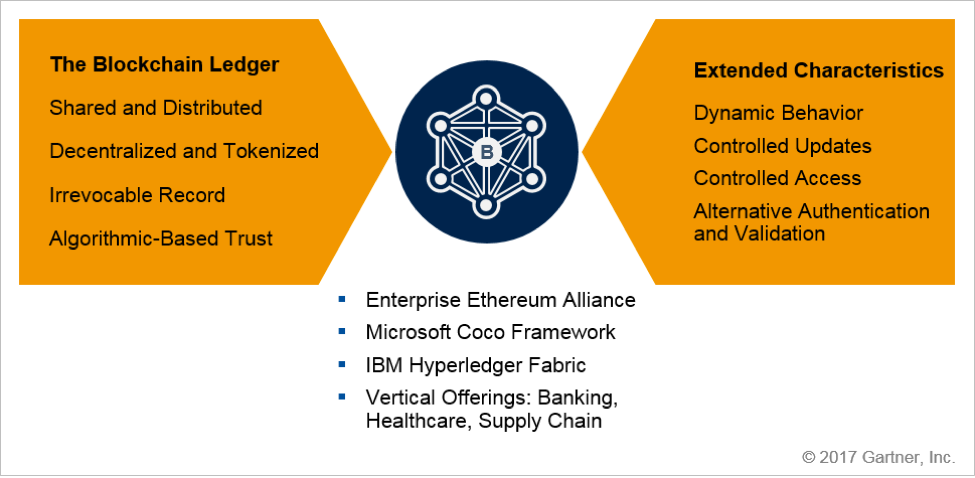
Event-driven: Gartner suggests that enterprises should embrace “event thinking,” given that by 2020, event-sourced, real-time situational awareness will be a required characteristic for 80% of digital business solutions, and 80% of new business ecosystems will require support for event processing. We’re increasingly moving toward systems that are controlled by specific events, rather than more traditional programming requests. This is being driven by the move to digital business, Cearley said. Technology providers will incorporate more event-driven approaches across their product lines. Examples include Salesforce, with its Platform Events, and SAP, with the SAP Event Stream Processor.
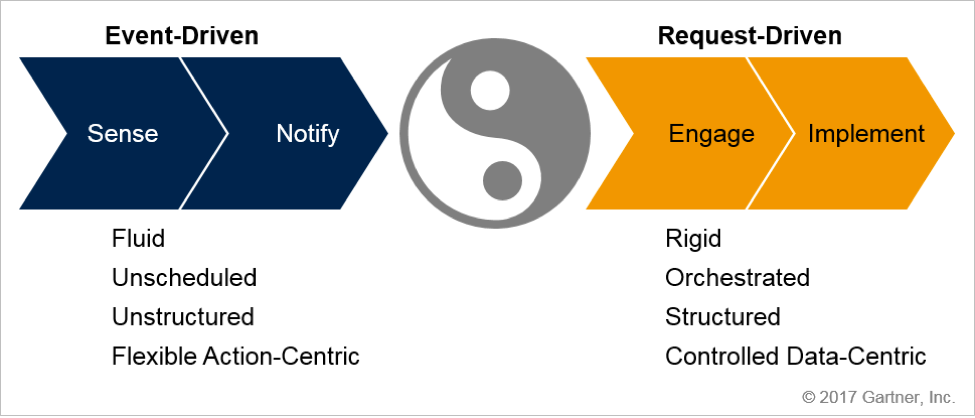
Continuous adaptive risk and trust: The organization sees digital corporate enterprises embracing a continuous adaptive risk and trust assessment (CARTA) model as security becomes more vital in a digital world. CARTA empowers companies to provide real-time, risk and trust-based decision making. To make CARTA a reality, organizations should explore integrating security into their DevOps efforts to deliver a continuous SecDevOps (security, development, ops) process, as well as explore deception technologies to catch bad actors that have penetrated the organization’s network. Cearley talked about more specific requirements, such as automated testing, role-based security, and training developers to understand security, as well as new ways of identifying the bad guys. By 2020, he said, 25 percent of new digital business initiatives will adopt a CARTA approach, up from less than 5 percent in 2017.
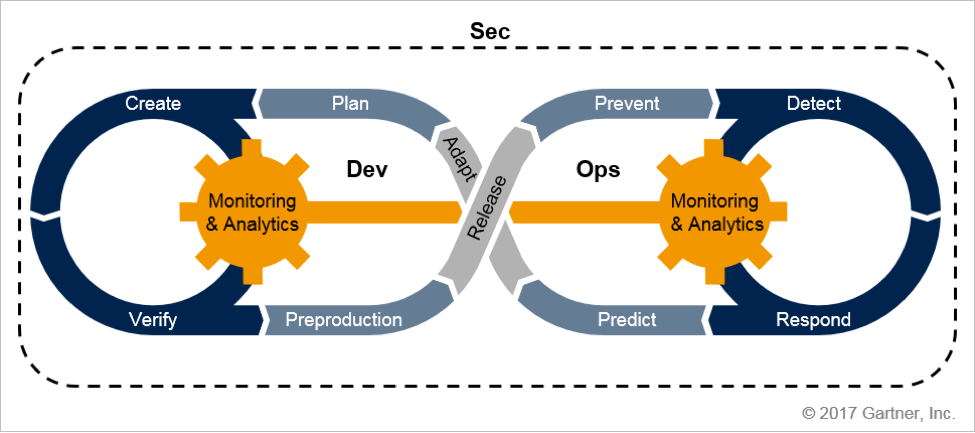
Reference:
David W. Cearley, Brian Burke, Samantha Searle, Mike J. Walker (2017, October 3). Gartner – Top 10 Strategic Technology Trends For 2018: https://www.gartner.com/doc/3811368?refval=&pcp=mpe#a1397498240
Gartnervideo (2017, October 3). Gartner YouTube: https://www.youtube.com/watch?v=TPbKyD2bAR4
Kasey Panetta (2017, October 3). Smarter With Gartner: https://www.gartner.com/smarterwithgartner/gartner-top-10-strategic-technology-trends-for-2018/
Michael J. Miller (2017, October 5). PCMag – Top 10 Strategic Technology Trends for 2018: https://pcmag.com/article/356651/gartners-top-10-strategic-technology-trends-for-2018
Christina Cardoza (2017, October 4). SD Times – Top 10 Strategic Technology Trends for 2018: https://sdtimes.com/gartners-top-10-technology-trends-2018/
Brian Barrett (2018, February 9). Wired – Inside The Olympics Opening Ceremony World-Record Drone Show: https://www.wired.com/story/olympics-opening-ceremony-drone-show/
Sarah Perez (2017, February 3). TechCrunch – Domino’s now lets you order from its full menu via Messenger – no setup or account required: https://techcrunch.com/2017/02/03/dominos-now-lets-you-order-from-its-full-menu-via-messenger-no-setup-or-account-required/
Fred Beer (2017, September 5). Disruptive Changes in Technology: 2017



